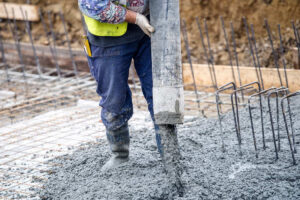
Understanding Textured Concrete
Textured concrete is a popular choice for adding dimension and visual interest to both interior and exterior surfaces. Unlike stamped concrete, which has a more uniform appearance, textured concrete offers a more irregular and natural look. The texture is achieved through the use of concrete saws, form liners, or even by hand, creating distinct lines or joints that give the concrete its unique character.
One of the key benefits of textured concrete is its ability to mimic the appearance of authentic materials such as wood, stone, and brick, while costing significantly less. This makes it a cost-effective solution for achieving the desired aesthetic without compromising on quality or durability.
Exploring the Possibilities
Textured concrete can be used in a variety of applications, from decorative overlays to full-scale construction projects. Here are some of the ways in which textured concrete can be utilized:
Decorative Overlays
Decorative concrete overlays offer a practical and affordable way to add the charm of natural-looking wood, stone, or other textures to both interior and exterior spaces. The process involves pouring fresh concrete into a form liner and allowing it to cure. Once cured, the surface can be custom-dyed to achieve a realistic effect.
Stains, integrated pigments, color hardeners, and dyes are all options for coloring concrete overlays. Each technique provides a unique aesthetic, allowing for endless creativity and customization.
Form Liners
Form liners are an essential tool for creating textured concrete surfaces. They enable architects and designers to incorporate a variety of textures and distinctive designs into concrete walls, giving the appearance of genuine stone or brick at a fraction of the cost.
Form liners are typically made from polyurethane or plastic, although other materials can be used. The design process starts with the architect’s vision, which is then translated into a primary texture or mold. Custom and pre-made form liners are available from manufacturers, offering a wide range of design options to suit any project.
Staining and Coloring
Once the desired texture has been achieved using form liners or other techniques, staining is often applied to enhance the appearance of the textured concrete. Concrete staining permeates the surface, creating a long-lasting color that will not chip, peel, or fade over time. Stains come in a variety of colors and hues, allowing for customization and the creation of unique and eye-catching designs.
Choosing the right concrete stain colors is crucial for achieving the desired look. Earth tones and transparent variegated colors are popular choices, as they provide a natural and realistic appearance. Additionally, concrete stains can be used to imitate the look of other materials, such as wood or stone, giving the concrete a more organic and textured feel.
Factors to Consider When Choosing a Texture
With so many options available, choosing the perfect concrete texture can be overwhelming. To help you make an informed decision, consider the following factors:
Design Theme
The texture of the concrete should complement the overall design theme of your project. Consider whether you want a more modern, contemporary look or a rustic, traditional aesthetic. The texture should enhance the desired style and create a cohesive and visually pleasing space.
Functionality
Think about the intended use of the concrete surface. Will it be a high-traffic area, such as a driveway or walkway, or a decorative feature in a garden or patio? The texture should provide the necessary traction and durability for its intended purpose while still maintaining its visual appeal.
Maintenance
Consider the level of maintenance required for the chosen texture. Some textures may require more frequent cleaning or sealing to maintain their appearance. Ensure that you are willing to invest the time and effort needed to keep the texture looking its best.
Budget
While textured concrete offers a cost-effective alternative to natural materials, it is still important to consider your budget when choosing a texture. Some textures may require more labor-intensive techniques or specialized materials, which can impact the overall cost of the project. Set a realistic budget and explore options that fit within your financial constraints.
Popular Textured Concrete Designs
Now that you have a better understanding of textured concrete and the factors to consider, let’s explore some popular textured concrete designs that can elevate the look of your project:
Slate Texture
Slate texture is a versatile option that can be used to create a sleek and modern look. Its smooth surface and fine lines make it ideal for contemporary designs. Slate-textured concrete is often used for flooring, countertops, and accent walls, adding a touch of sophistication to any space.
Cobblestone Texture
Cobblestone texture provides a timeless and rustic charm to any surface. With its irregular shape and rough texture, it is reminiscent of old-world European streets. Cobblestone-textured concrete is often used for driveways, walkways, and outdoor patios, creating a warm and inviting atmosphere.
Wood Grain Texture
Wood grain texture offers the beauty and warmth of natural wood without the maintenance requirements. It is a popular choice for flooring and outdoor decking, providing a realistic and durable alternative to traditional wood. Wood grain-textured concrete can be customized with different.
Textured concrete offers architects and designers a unique and versatile way to add dimension and visual interest to their projects. By understanding the different types of textured concrete, considering design elements such as texture, pattern, and color, and utilizing form liners and concrete stains, architects and designers can create stunning and visually appealing spaces. With proper maintenance, textured concrete will continue to impress and inspire for years to come.
Contact us (513-617-1401) for more information or a quote
—

About ABS Services
ABS Services provides comprehensive commercial construction services to Greater Cincinnati, Northern Kentucky, and Southeast Indiana. We have the experience, equipment, and the right team to get the job done!
> Learn More
